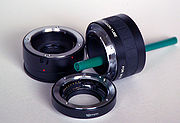
Extension tube
Encyclopedia

Lens mount
A lens mount is an interface — mechanical and often also electrical — between a photographic camera body and a lens. It is confined to cameras where the body allows interchangeable lenses, most usually the single lens reflex type or any movie camera of 16 mm or higher gauge...
, used primarily for macro photography
Macro photography
Macrophotography is close-up photography, usually of very small subjects. Classically a macrophotograph is one in which the size of the subject on the negative is greater than life size. However in modern use it refers to a finished photograph of a subject at greater than life size...
. The tube contains no optical elements; its sole purpose is to move the lens farther from the image plane. The farther away the lens is, the closer the focus, the greater the magnification, and also the greater the loss of light (requiring a longer exposure time). Lenses classically focus closer than infinity by moving all optical elements farther from the film or sensor; an extension tube simply imposes this movement.
Extension tubes without electrical contacts will not allow an electronic automatic camera to control the lens, thus disabling autofocus
Autofocus
An autofocus optical system uses a sensor, a control system and a motor to focus fully automatic or on a manually selected point or area. An electronic rangefinder has a display instead of the motor; the adjustment of the optical system has to be done manually until indication...
and in some cases forcing a user to shoot wide open
Aperture
In optics, an aperture is a hole or an opening through which light travels. More specifically, the aperture of an optical system is the opening that determines the cone angle of a bundle of rays that come to a focus in the image plane. The aperture determines how collimated the admitted rays are,...
unless the lens offers manual aperture control. More expensive extension tubes contain electrical contacts allowing the user to use autofocus
Autofocus
An autofocus optical system uses a sensor, a control system and a motor to focus fully automatic or on a manually selected point or area. An electronic rangefinder has a display instead of the motor; the adjustment of the optical system has to be done manually until indication...
and electronically control the aperture of the attached lens. A great advantage to the non-electrical tubes is their low price. Since no electronics or optics is involved, it is often possible to purchase rings for as little as $4 USD.
Other items like lens adapters may unintentionally have an effect similar to an extension tube. A lens designed for a small flange focal distance
Flange focal distance
For an interchangeable lens camera, the flange focal distance of a lens mount system is the distance from the mounting flange to the...
may not be able to focus to infinity when a lens adapter places the sensor too far away.
Versus teleconverters
Extension tubes are sometimes confused with teleconverterTeleconverter
A teleconverter is a secondary lens which is mounted between the camera and a photographic lens. Its job is to enlarge the central part of an image obtained by the objective lens...
s, an optical component (i.e., containing lenses) designed to increase effective focal length.
External links
- DIY Extension Tube How to easily build your own extension tube.
- Canon EF 25mm Extension Tube II review at www.the-digital-picture.com
- "Close-up and Macro Photography" by Chuon-Szen Ong, Chapter "Extension tubes" at Nikonians.org
- Extension Tubes for Macro Photos at www.shutterfreaks.com
- Kenko Extension Tube Set review at www.the-digital-picture.com
- Experiments with Close-up Lenses and Extension Tubes

